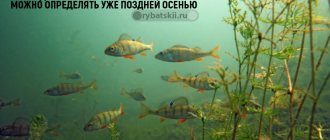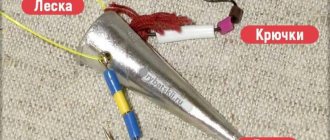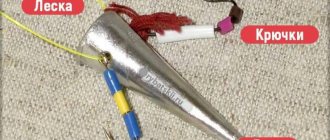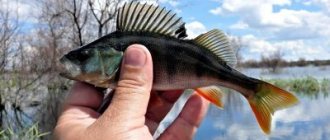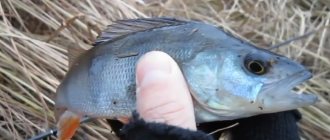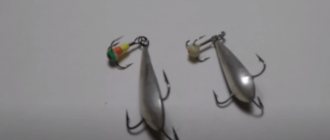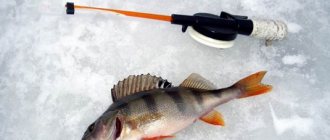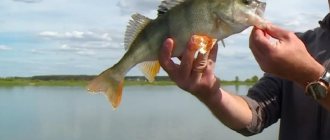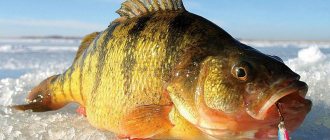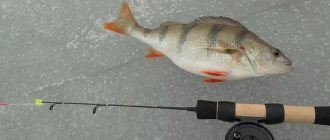Search Locations
Perch bites better in winter from the moment the ice begins to form; this period lasts 2–4 weeks. The predator has not yet changed its usual habitats; it shows a high interest in the offered baits and actively feeds. As soon as the thickness of the ice cover begins to increase, it moves away from the coastal zone and descends into the pits. A good catch can be obtained until the beginning of January.
At the beginning of winter, perch prowls near the shores; during the deep winter, it is at depth, almost at the very bottom. As spring approaches, minke whales begin to gradually reach shallow depths; with the last ice, they can be safely caught in shallow water. Here they actively swallow oxygen.
Knowing the intricacies of catching perch with a jig in winter, including the selection of promising points, you can catch both medium and large individuals. A modern and multifunctional gadget such as an echo sounder will help the fisherman. It will reduce both the time and effort needed to find jobs. If the frosts are not severe, then perch can be found in winter at the outlet and depth. It is also worth fishing in flooded ravines, hills, and places near old riverbeds. Only severe frosts, from -15 °C, force the predator to descend into the pits.
The search for catchable places depends on the winter period
First ice. It’s best to go perch fishing in winter in calm weather. It is better in the morning or in the middle of the day, results are possible in the evening. Fishing at this time becomes unpredictable, there is a high probability of catching a trophy. Promising places include:
- depth changes;
- snowy terrain;
- heaps of stones at the bottom;
- eyebrows;
- areas near coastal vegetation;
- places where you can set up ambushes.
Midwinter. Perch migrates throughout the reservoir, gathering in schools of 7–9 individuals. Against the background of severe frosts, the fish experiences a lot of inconvenience; it seeks more comfortable conditions with a water temperature within 4 °C. It reacts weakly to baits, even the most catchy ones. Considering that during this period the oxygen concentration is low, you should look for fish on:
- deep-sea areas;
- underwater channels that flow into rivers and streams with moderate currents.
End of winter. On the eve of warming, underwater inhabitants begin to become more active and feed intensively. Stripers begin to hunt for fry; they are most often found near areas where meltwater and streams flow into.
Fishing with lures
Modern fishermen have no shortage of choice of artificial baits, including spinners. They differ from each other in shape, size, material of manufacture and play in the water column. It has been noticed that for catching humpback whales it is better to use matte spoons made of tin, brass, copper and silver. On the first ice, equip your rods with small spoons, and increase their size as the winter progresses.
An ordinary winter fishing rod with a reel or reel is suitable as gear. It is advisable to use a whip that is long enough and flexible. The range of line thickness ranges from 0.15 to 0.3 mm.
The fisherman determines the depth of the fishing spot so that he knows how much fishing line he will need. The tackle is immersed in the water so that the spoon does not reach the very bottom a few centimeters. With a sharp swing of the fishing rod, the lure is lifted up 50-60 cm, then the tackle is allowed to fall down. During the game, the optimal pace is selected.
Fishing Tips: How to Build an Ice Fishing Tent - How to Best Use it
If no bites occur in the bottom layers, start fishing in other layers of the reservoir. To achieve good catches, a fisherman must have a large selection of different baits.
Many fishermen are looking forward to the formation of strong ice on the surface of the water in order to enjoy the much-coveted perch fishing.
How to catch perch in winter using a jig
The advantage of perch fishing in winter is the distribution of the target; it can be found in almost any body of water. To provoke him to grab the bait, you will need both patience and competent tactics.
Fishing efficiency will be higher if you attach a bloodworm to the jig hook. But if you choose the right bait and present it to the striped robber, the chances of a catch will greatly increase.
Despite the ubiquity of perch and its good appetite, attracting its attention and catching it is possible only if the following rules are observed:
- Determine the working depth and where the flock gathers.
- Determine by experiment the best jig wiring. Depending on the mood of the predator, it can be either moderate or aggressive.
- Count the number of fish caught until the bite in the hole stops.
- As complementary food for perch in winter, located at a depth of up to 4 m, it is worth using a composition based on crushed bloodworms. The predator quickly detects such bait and shows increased interest in the bait.
- You need to select a tool, line thickness and jig size taking into account specific fishing conditions and the nature of the reservoir.
Only an integrated approach guarantees not only qualitative, but also quantitative catch.
Selection and features of gear for catching perch in December
Winter fishing rod
Almost any winter fishing rod is suitable for striper fishing in December. There will also be no difficulties with the selection of fishing line - perch, as a rule, does not tear it.
Meanwhile, you should especially carefully choose a nod, while taking into account the weight of the bait. So, when trolling, a fairly rigid nod may be suitable, no more than 6 centimeters, in which the bending angle under the weight of the lure is about twenty to thirty degrees.
Most often, despite the variety of gear, anglers on the first ice still prefer to catch perch using the trolling method. Thus, you can catch a large minke whale, sometimes even a trophy one. In addition, according to anglers, the striped robber is more likely to notice a spinner than a small jig.
At the same time, I advise experienced fishermen to take a variety of baits:
- spinners,
- balancers,
- jigs.
This is due to the fact that sometimes only during fishing can you determine which of these baits will appeal to the perch more. Let's look at each of them in more detail.
Spoon
Lure fishing is a classic of perch fishing. Experienced fishermen advise drilling holes at a distance of ten meters from each other. Fishing rods for trolling perch are a rod with a reel, a whip two to five to thirty centimeters long and a nod made of nipple rubber or a nod made of lavsan.
In addition, it is possible to use a “filly” - a winter fishing rod without a nod, with a foam or cork handle and a carbon fiber whip, 35-40 centimeters long
We wind 0.12-0.16 fishing line on these fishing rods - it all depends on the depth in this place, as well as how much the bait weighs. Spoons for catching perch on the first ice should be small - thirty to fifty millimeters in size.
Balance
Catching perch using balance beams is very popular, including in winter. On the first ice, baits ranging in size from twenty to seventy millimeters are suitable.
Mormyshka
Fishing for perch using a jig is also one of the most popular. At the same time, the fish reacts not so much to the shape of the jig, but to the play with it.
The jig should be small or medium. The shape of this bait can be as follows:
- spherical,
- spherical,
- rectangular,
- large cylindrical.
In the horizontal plane, the jig should not be longer than five to seven millimeters.
The best attachments for jigs are:
- burdock moth larva,
- small maggot.
If you fish without baits, then the game should be very fast, up to 300 vibrations per minute. But even in this case, it is recommended to wear a dark or bright cambric on the shank of the hook for successful fishing.
Playing technique
The correct technique for catching perch when ice fishing guarantees results. Here you need to know that catching fish with a reelless method and with the addition of a bloodworm is different, each has its own nuances.
With bloodworm infusion
When a predator sees larvae, bugs, and especially bloodworms, it immediately captures them. This proven method works everywhere and always. There are 4 varieties of the game:
- Let the jig sink to the bottom and tap it 5-6 times. Then gently lift it by 5–6 cm and hold it at the top point for a couple of seconds. This cycle of manipulations is repeated again.
- Lower the bait to the bottom, lift it by 25–30 cm, at this moment making small oscillatory movements using a fishing rod. Then the cycle is repeated.
- Raise the bait 20–25 cm from the bottom surface, tapping your finger on the rod itself. Such a simple game is often successful.
- Place a catchy jig on the perch a couple of centimeters from the bottom, setting an active game with pauses of 2-3 seconds.
The animations listed above allow you to catch perch at the bottom, in the middle, and in the upper horizons of the reservoir. Such basic techniques can be safely used on any body of water and in any mood of the predator.
Read how to catch perch in February and prepare fishing tactics.
Catching perch with a reelless reel
It is possible to attract a striped robber to a jig without adding bloodworms only if the action of the bait is uniform and monotonous. Basically, the reelless bait for perch is gradually lifted and its movements are set to monotony. Then they lower it to the bottom and repeat the wiring. Considering that the predator often attacks the prey near the bottom, the bait at this level should also have an interesting game. If within 1-2 hours the perch has not shown interest in the bait, then the game should be changed and diversified:
- make stops every 5–7 seconds, lasting 4–5 seconds;
- vary the pace of the game, sometimes slowing it down, sometimes speeding it up.
These provocative moments in the basic mothless game provide an opportunity to quickly attract the attention of the striped predator.
Catching perch on the river with a spinning rod
Catching perch with a spinning rod
All the intricacies of catching perch with a spinning rod have already been outlined in the article about spinning perch fishing. Let's decide on the gear and choice of bait for fishing on the river.
To catch perch on the river using a spinning rod, you need to choose a light or ultralight class rod with a medium or fast action. The rod test should range from approximately 1 to 18 grams. You should not use leashes to catch perch. Leashes are used only if they also expect a bite from a predator such as a pike. The presence of a leash, although it will protect against pike biting the fishing line, can affect the number of perch bites. A fishing line with a diameter of 0.15-0.2 mm is suitable. Well, in general, there is a good article on how to choose a spinning rod for perch.
The wiring of the bait depends on its type. If you are catching perch on the river with a jig, then you need to use stepped wiring; if you are fishing with wobblers, then it is better to use twitching wiring, that is, move the bait in jerks. Uniform wiring is excellent when fishing with baits such as castmaster, rotating and oscillating spoons. You can find out more about spinning fishing here.
Rotating lures for perch
Wobblers for perch
To catch perch on the river, it is better to have a good variety of spinning baits so that you can always choose the most suitable and catchy one.
On the left are examples of very good rotating spoons for catching perch on the river, which are distinguished by very good efficiency and catchability.
On the right you can look at the catchy perch wobblers that professionals and simply experienced perch hunters love to fish with. Such wobblers are almost universal for any body of water and produce incredible results in catching perch.
But these, of course, are not all the baits that can be used to catch perch. There are many others, among which you will definitely find catchy ones. Buy new baits regularly, test them on every fishing trip, but always have already proven ones with you, which will not allow you to be left without a catch. Some of these are exactly what are shown in the pictures.
How to feed a predator
To improve the intensity of the bite, experienced fishermen prepare appetizing bait. Here it is important to maintain the ratio of the components used.
Among the best options for bait compositions it is worth noting:
- Earthworm. But it needs to be prepared in the fall. For long-term storage, a plastic container with a damp substrate, which is placed in a cool place, is suitable. Periodically, the worms need to be fed, the soil moistened and loosened. Before use, earthworms are crushed and combined with breadcrumbs.
- Bloodworm. First, it is rubbed with your fingers to enhance the smell of the future bait, and also mixed with breadcrumbs.
- Fresh pig blood. It goes better with bread crumbs. The main thing here is to achieve a thick dough-like state. The finished mixture is wrapped in film and sausages are formed. In winter, on a pond, they quickly harden, breaking off the required amount is not difficult.
You can fill a rubber glove with fresh blood from some animal or bird, and after making a puncture, lower it into the hole.
If fishing takes place with a jig with bloodworms, then bait is also made from it. The perch, having noticed the food falling to the bottom, will become interested and immediately head towards it. As the attractive mixture rises, the predator will peck higher and higher. When fishing at shallow depths, it can take almost right to the surface.
Biting and fishing
Winter fishing for large and medium-sized perch using bloodworms does not involve quick hooking; the fished object often hooks itself. But catching a predator with a reelless reel, on the contrary, requires an immediate reaction; strike at any suspicion of a bite. In this case, the predator immediately recognizes the catch and spits out the inedible bait. In addition, when the fish feels the sting of the hook, it is impossible to catch it a second time.
Fishing should not be too sharp, preferably soft, but with some tension. Often the striped predator clings to the hook only with the edge of its mouth. If you overdo it with pressure, the fish will break loose and scare away the rest of the perches; in this case, you won’t be able to expect bites.
Fishing rod rig
For an interesting game with a jig from the ice to a perch, you will need high-quality and balanced tackle.
Fishing rod
A light fishing rod 20–25 cm long is perfect for perch in winter. For example, a balalaika. The main thing in choosing a tool is ease of use. It should fit comfortably in the hand, have a handle made of materials suitable for cold conditions, and be equipped with a reliable reel that does not stick during operation.
Nod
For perch, a nod 4–5 cm long and 2–3 mm wide is selected. The degree of rigidity directly depends on the weight of the bait used. It is optimal to have several fishing rods with nods of different rigidity.
When the guard and the jig correspond to each other, its angle of inclination is 45 degrees. For better visualization, the bite alarm is painted in bright colors, usually red. Regular nail polish and a waterproof marker work well here.
Fishing line for perch in winter using a jig
When using jigs on a predator, it is good to use monofilament with a thickness of 0.08-0.1 m. To catch individuals weighing 300–400 g, you will need a monofilament line with a cross-section of 0.12 mm. Thick threads are not relevant here, the bait goes down much slower, its action turns out to be “rough”, and the fish gets scared of it and moves away.
Among sports fishermen, monofilament with a thickness of 0.05-0.06 mm is extremely popular. The breaking load of such lines is only a few hundred grams. For novice fishermen, using such equipment is often very difficult; experience is required.
When choosing winter fishing line for perch, you need to focus on trusted manufacturers. There is monofilament fishing line on sale, where the stated diameter does not correspond to reality, for example, a 0.08 mm thread can be 0.1 mm or more. A quality product cannot be cheap.
To catch a striped robber with one tackle you will need 15–25 m of monofilament. To equip 2-3 fishing rods, one unwinding in 50 is enough. If there are 4-5 tackles, then the 100th reel will be used.
Jigs
Lead, tin or tungsten are used to make jigs. Tungsten baits are the priority for perch. Often lead products have a slightly dull hook. Jigs work for predators in the form of:
- drops;
- rhombus;
- circle;
- banana;
- flies and other insects.
It is better to choose the color of the jig from natural ones. It is impossible to immediately identify the preferences of a predator; here you need to experiment. In the dead of winter, when fishing for perch at a depth of up to 1.5 m, versions of dark tones, as well as silver-dark ones, will be attracted. At a depth of over 2 meters, silver, golden and yellow baits will be effective. If there is no reaction from the perch to them, you can try your luck with bright jigs.
On the first ice for perch, the weight of the jig should be 0.3-0.4 grams. During these periods of winter, fish respond better to large baits of 3–4 and 5 mm. They are clearly visible in the water, and the game turns out to be interesting, and the tackle sinks faster.
Thin rigs work against a passive predator. The size of the bait is no more than 2-2.8 mm, which is 0.2-0.3 g. They are used at a depth of up to 6 m. Devils and witches are very popular among winter anglers. The first are jigs, which, in addition to one solid hook, are also equipped with a tee, and the second have 4 hooks, fastened with a wire frame.
Catching perch in winter with a jig is an exciting activity that requires constant movement around the reservoir. It is better to drill holes in a checkerboard pattern, maintaining a distance of 5–10 m between them. The main thing is to prevent the drill from coming into contact with the ground, otherwise the knives will quickly become dull. To increase your chances of catching, it is worth having different baits and a bait mixture that is attractive to predators.
Choice of spinners
The spoon must meet the requirements that the perch “makes” for the quality and size of this bait.
First of all, it should be small in size; these are baits numbers from 1 to 3 according to the generally accepted classification . Very small spoons are inconvenient because they are difficult to cast, especially in windy weather, a considerable distance from the shore. Too large specimens of perch will not be of interest. Therefore, baits are 3-5 cm in size and weigh up to 10 grams. have the highest catch rates.
As for color, lures are selected in bright colors of red and yellow; silver-coated lures or carefully polished steel lures work well.
The hooks with which the spinner is equipped must be of the highest quality. Typically, one small tee is used, which is attached to the tail of the spoon. If during the fishing process the hook becomes slightly dull, it can be brought back into working condition using a matchbox. To do this, the dry hook should be sharpened with the abrasive side on which the match is struck.
The shape of the spoon should be oblong, because perch prefers to eat fry of various fish species. The “oscillator” should have a slightly curved shape, which allows it to create movements during wiring that resemble a fish that is wounded or stunned.
Very good catches are obtained by models that allow you to place the bait when retrieving in the upper layer of water, while the “fish” itself should seem to swim sideways, which indicates to the predator its inability to fully escape.
Tips for a fisherman: Catching perch with a reelless video 2021 - Answers for beginners
To choose the right bait from the variety of spinners that are produced by various manufacturers, experience is needed. If a fisherman is just mastering the techniques of trolling such a predatory fish as perch, then there is no need to buy very expensive baits.
To begin with, domestically produced models or mid-price models from well-known manufacturers are suitable.
You can make a spinner with your own hands, and if you pay attention to the recommendations, it is quite possible to create a bait that will work no worse than purchased models, and the cost of making a spinner will be equal to the cost of a treble hook, which you will need to purchase in a store.
For a whole year we were thinking about how to repeat our pleasant experience of fishing for large perches on the Irtysh. Almost a month of preparation, four days of travel, five hundred liters of fuel and six days on ice. This was the first experience of complete autonomy on the water and, in our opinion, very successful. And as usual, with the right places, there shouldn’t be any problems with the fish.
For a whole year we were thinking about how to repeat our pleasant experience of fishing for large perches on the Irtysh. Almost a month of preparation, four days of travel, five hundred liters of fuel and six days on ice. This was the first experience of complete autonomy on the water and, in our opinion, very successful. And as usual, with the right places, there shouldn’t be any problems with the fish.
Winter fishing for perch, lures and balance beams. This is the first successful perch fishing this season 2018-2019, at the same time I tested a new fishing rod and higashi reel. A homemade spinner, the balancer MULL Yaman, and a NAMAZU spinner TORPEDO 25 mm 3 g worked well.
It is possible to catch perch in winter using various baits. These include:
